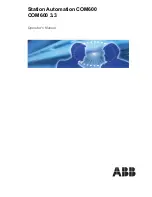
4: Configuration Using Web Manager
PremierWave® 2050 802.11ac Embedded Wi-Fi® User Guide
24
Navigating Web Manager
The table below provides a shortcut to the various software features available for viewing and
configuration through Web Manager.
Table 4-5 Web Manager Pages
Web Manager Page
Description
Page
Status
Shows product information, network, line, and tunneling settings.
Access Point
Allows you to configure an access point and shows the current operational
state of existing access points.
Bridge
Allows you to configure a bridge and shows the current operational state of
the bridge.
CLI
Shows Command Line Interface (CLI) statistics and lets you change the
current CLI configuration settings.
Clock
Allows you to view and configure the current date, time and time zone as it
displays in web manager.
Diagnostics
Lets you perform various diagnostic procedures.
Discovery
Allows you to view and modify the configuration and statistics for device
discovery.
DNS
Displays the current status of the DNS subsystem.
FTP
Shows statistics and lets you change the current configuration for the File
Transfer Protocol (FTP) server.
Hardware
Shows hardware status and configuration options.
HTTP
Shows Hyper Text Transfer Protocol (HTTP) statistics and lets you change
the current configuration and authentication settings.
IP Sockets
Shows IP socket status and lets you change hardware configuration.
Line
Shows statistics and lets you change the current configuration and
Command mode settings of a serial line.
Log
Shows and allows changes with logs.
Memory
Shows memory status and lets you change hardware configuration.
Network
Shows status and lets you configure the network interface.
Ping
Shows how to ping a network host with a DNS hostname or IP address.
Processes
Shows the processes currently running on the system.
Protocol Stack
Lets you perform lower level network stack-specific activities.
QuickConnect
Lets you change configuration settings for the Quick Connect.
Quick Setup
Shows the quick setup configuration options for the device.
Routes
Shows the current system routing table.
Threads
Shows thread ID numbers, names and CPU usage.
Traceroute
Shows how to perform a traceroute to a network host.
User Management
Shows the configuration of users.
SSL
Lets you upload an existing certificate or create a new self-signed
certificate.
Syslog
Lets you specify the severity of events to log and the server and ports to
which the syslog should be sent.
















































